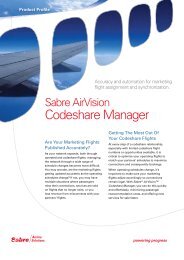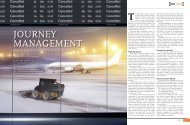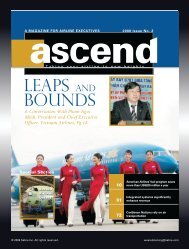2009 Issue 1 - Sabre Airline Solutions
2009 Issue 1 - Sabre Airline Solutions
2009 Issue 1 - Sabre Airline Solutions
Create successful ePaper yourself
Turn your PDF publications into a flip-book with our unique Google optimized e-Paper software.
During the last five years, major aircraft<br />
manufacturers have enjoyed record orders<br />
from airlines across the globe. Granted, the<br />
distribution of these orders has been focused on<br />
the rapidly growing Indian domestic market and<br />
aggressively expanding Middle Eastern carriers.<br />
U.S. domestic network carriers, still recovering<br />
from the fallout of geopolitical situations and<br />
declining economic conditions, have been slow<br />
in ordering new aircraft to replace aging fleets<br />
of narrow-body aircraft and first-generation twin<br />
wide-body aircraft.<br />
As of January, Boeing racked up a healthy<br />
backlog of more than 3,700 aircraft with an<br />
amazing 913 Boeing 787s ordered, while Airbus<br />
enjoys a backlog of 3,715 aircraft, including<br />
478 of its recently launched Airbus A350 extrawide-body<br />
aircraft. The prevailing demand for<br />
efficient wide-body aircraft and the evolving<br />
route-map structure created demand for new<br />
fleet types with enhanced mission capability<br />
and operating range. When first introduced to<br />
the airline community, there was a level of<br />
excitement unparalleled in the industry for the<br />
Boeing 787 and competing Airbus A350 aircraft.<br />
Carriers saw the opportunity to fundamentally<br />
change the flow of international passenger traffic<br />
through bypassing congested gateways such as<br />
London Heathrow Airport and New York’s John F.<br />
Kennedy International Airport and offering more<br />
direct scheduled services to/from secondary<br />
markets.<br />
External factors such as the rapid increase<br />
in the price of jet fuel (especially during 2008),<br />
the passing of the U.S.-European open-skies<br />
agreements, the approval of anti-trust partnerships<br />
across the North Atlantic and the continued<br />
growth in global airline alliances only added to the<br />
frenzy of demand for new aircraft to serve newly<br />
conceived city-pair markets. There seemed to be<br />
no end in sight for the record orders of aircraft at<br />
the two leading aircraft manufacturers.<br />
The introduction of the new wide bodies<br />
promised the utilization of the latest technological<br />
advances, especially around engine performance<br />
and airframe construction techniques.<br />
Boeing believed that the opportunity was ripe<br />
to develop and mass produce the world’s first<br />
commercial passenger aircraft using advanced<br />
composite materials, which offered significant<br />
weight savings that would in turn lead to more<br />
efficient operating in terms of fuel consumption<br />
and environmental impact. Experiences with the<br />
increasing use of composite materials across<br />
the airframe, along with the decades-long use of<br />
such materials in military and business jet construction,<br />
provided the foundation for launching<br />
the next-generation of wide-body aircraft.<br />
With these new technologies and construction<br />
techniques came the risk of uncertainty.<br />
Adding to this risk, a decision was made to outsource<br />
a larger portion of the airframe construction<br />
to key manufacturing partners across the<br />
globe, introducing an added level of complexity<br />
in the logistics and distribution arena.<br />
Ultimately, numerous factors centered<br />
around the construction of the aircraft frame,<br />
which resulted in a significant delay in the Boeing<br />
787 program. The 787 now has an anticipated<br />
delivery date three years later than originally<br />
planned. Adding to Boeing’s woes was an unexpected<br />
and prolonged strike by its machinist<br />
union, which more or less shut down production<br />
late last year. Airbus has also had its own share of<br />
setbacks, with the introduction of the ultra-large<br />
A380 aircraft severely impacting the availability of<br />
engineering and design resources to work on the<br />
A350 program to compete against Boeing.<br />
In both the B787 and A380 programs,<br />
aggressive product development and delivery<br />
timelines were negatively impacted by unexpected<br />
manufacturing challenges that resulted in<br />
multiple rounds of part redesigns and/or reworks.<br />
In many cases, partially constructed aircraft sat<br />
idle along the assembly lines until engineers<br />
could figure out an efficient and effective way to<br />
resolve the problems. Ultimately, the B787 and<br />
competing A350, along with the A380, will be<br />
great aircraft in their own right, but these delays<br />
have had tremendous impact on fleet planning<br />
departments around the world. Carriers have<br />
been forced to delay the launch of new routes,<br />
the retirement of aging and less-efficient aircraft<br />
types, and, in some cases, newly established carriers<br />
have been forced to entirely postpone their<br />
launch date.<br />
By far, northern Asia airlines have been<br />
impacted the most by the B787 delays. Launch<br />
customers ANA and JAL in Japan anticipated<br />
taking deliveries of their first batch of aircraft<br />
during the first half of 2008. Some Chinese carriers<br />
expected to receive the new aircraft in time<br />
for the summer Olympics in Beijing. While the<br />
disappointment from the missed opportunity to<br />
showcase the new advanced aircraft as part of<br />
the Olympic celebrations subsides, the carriers<br />
remain eager to receive their aircraft. As a stopgap<br />
to these aircraft delays, ANA and JAL have<br />
been forced to place supplemental orders for the<br />
venerable B767-300 aircraft as well as postpone<br />
the retirement of existing B767s in its operating<br />
fleet. In addition, Airbus has benefitted from an<br />
increased demand for its A330 series until the<br />
competing A350s come online.<br />
This situation has created a strong demand<br />
for these equipment types, which has resulted in<br />
higher leasing costs and residual values, delayed<br />
cargo conversion programs, and revised flight<br />
schedules. At the same time, many Asian carriers<br />
have elected to replace their aging B747-400s<br />
with twin-engine aircraft, especially the similarcapacity<br />
B777-300s. On most routes from Japan<br />
to North America, the B777-300 is becoming<br />
the aircraft of choice, replacing not only B747s<br />
but also MD-11s, which are being converted to<br />
freighter operations.<br />
On the regional front, Embraer and<br />
Bombardier have seen the continued interest in<br />
their product lines, especially in larger airframes,<br />
with record orders for the E-jets and stretched<br />
CRJ Series. In addition, there has been a healthy<br />
resurgence in the demand for advanced turboprop<br />
aircraft with some major network carriers reintroducing<br />
turboprop operations in their scheduled<br />
service. As a fallout to the run up in fuel prices,<br />
there has been a noticed reduction in smaller jet<br />
aircraft operations, with many network carriers<br />
opting to park their 50-seat regional jets. In return,<br />
they are upgrading to larger regional jets (ranging<br />
from 70 to 100 seats), downgrading to turboprop<br />
operations or exiting the given market altogether.<br />
A recent study by USA Today found that<br />
some major airports experienced more than a 30<br />
percent reduction in operations year over year.<br />
Nonetheless, regional aircraft manufacturers also<br />
Qatar, along with other prominent Middle east carriers, has slowed its growth plans as it<br />
awaits the arrival of wide-body aircraft such as the Airbus A350.<br />
ascend<br />
Photo courtesy of Airbus<br />
27<br />
industry
















